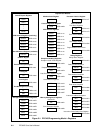
2-10 PPC405 Core User’s Manual
SPRG0–SPRG7 provide temporary storage locations. For example, an interrupt handler might save
the contents of a GPR to an SPRG, and later restore the GPR from it. This is faster than performing a
save/restore to memory. These registers are written by mtspr and read by mfspr.
Access to SPRG0–SPRG7 is privileged, except for read access to SPRG4–SPRG7. See “Privileged
SPRs” on page 2-32 for more information.
2.3.2.5 Processor Version Register (PVR)
The PVR is a read-only register that uniquely identifies a standard product or Core+ASIC
implementation. Software can examine the PVR to recognize implementation-dependent features and
determine available hardware resources.
Access to the PVR is privileged. See “Privileged SPRs” on page 2-32 for more information.
2.3.3 Condition Register (CR)
The CR contains eight 4-bit fields (CR0–CR7), as shown in Figure 3-8. The fields contain conditions
detected during the execution of integer or logical compare instructions, as indicated in the instruction
Figure 2-6. Special Purpose Register General (SPRG0–SPRG7)
0:31 General data Software value; no hardware usage.
Figure 2-7. Processor Version Register (PVR)
0:11 OWN Owner Identifier Identifies the owner of a core
12:15 PCF Processor Core Family Identifies the processor core family.
16:21 CAS Cache Array Sizes Identifies the cache array sizes.
22:25 PCL Processor Core Version Identifies the core version for a specific
combination of PVR[PCF] and PVR[CAS]
26:31 AID ASIC Identifier Assigned sequentially; identifies an ASIC
function, version, and technology
0 31
0 1112 1516 2122 2526 31
UDEF
OWN
CAS
PCL
AID


















